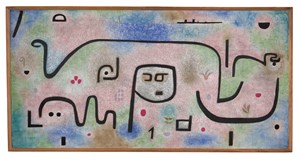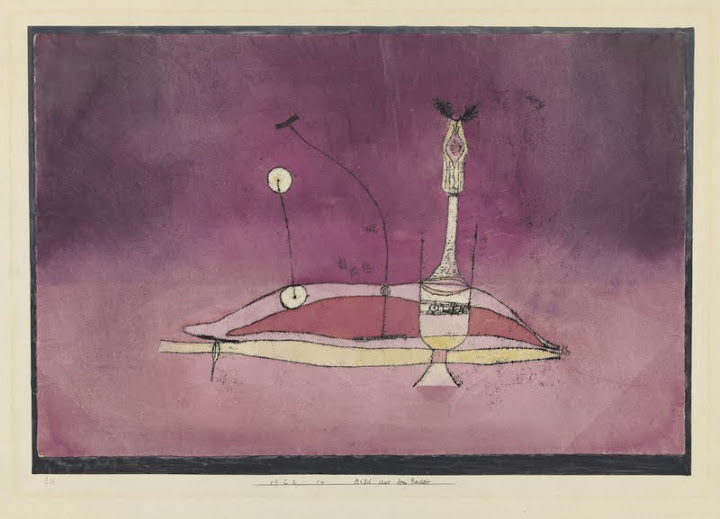
From April 6 until August 1, 2016 the Centre Pompidou is presenting a journey through the work of one of the 20th century’s most iconic artists: Paul Klee. Featuring two hundred and thirty works on loan from the Zentrum Paul Klee in Bern, and other pieces from various major international and private collections, this retrospective sheds new light on a rather intriguing aspect of the artist’s oeuvre.
From April 6 until August 1, 2016 the Centre Pompidou is presenting a journey through the work of one of the 20th century’s most iconic artists: Paul Klee. Featuring two hundred and thirty works on loan from the Zentrum Paul Klee in Bern, and other pieces from various major international and private collections, this retrospective sheds new light on a rather intriguing aspect of the artist’s oeuvre: the way he used irony when describing finite and infinite, real and ideal. Klee’s manner is regarded as childish and honest, personal and rhythmic (due to his musicality), contrasting with the mature colors and subject themes. While absorbing all the modern art movements around him, like Dada, Cubism, Surrealism, Constructivism and Abstraction he preserved his own recognizable style throughout his career.
Apart from being an artist, Klee was a remarkably talented musician, lecturer and author of “Writings on Form and Design Theory” (Schriften zur Form und Gestaltungslehre), published in English as the Paul Klee Notebooks, which are held to be of great importance for modern art.
The exhibition at the Centre Pompidou is divided into seven thematic sections highlighting each stage in Klee’s artistic development: Satirical beginnings, Klee and Cubism, Mechanical theatre (in line with Dada and Surrealism), Klee and Constructivisms (the Bauhaus years in Dessau), Looking back (on the 1930’s), Klee and Picasso, and finally The Crisis Years (marked by Nazi policies, war and illness).
A 312-page catalogue edited by the exhibition’s curator Angela Lampe, with 300 illustrations, and containing new contributions by internationally-acclaimed Klee specialists, is published by the Centre Pompidou on the occasion of this retrospective.
We had the chance to converse with Angela Lampe, curator of the “Paul Klee. L’ironie à L'oeuvre” retrospective.
Artdependence Magazine: Mrs. Lampe, what is your fascination for Paul Klee?
Angela Lampe: I am fascinated by his great subtlety, his gift to transpose profound and earnest themes in simple, lighthearted pictures.
AD: Why do you think Klee was so full of irony, or perhaps we can call it self-relativation?
AL: I think it was his nature. He wrote in 1906 in his diary: “No one has to get ironical about me, I see to that my myself.” His son Felix later recalls: ”He always had a great taste for satire, for irony, for everything that isn’t quite serious.” His irony stems from his distant attitude he has toward himself and his work.
AD: Was Klee influenced by Dadaism, Picasso's cubism, or did he want to be a part of these art movements?
AL: Klee wasn’t really influenced by Dada and Cubism and he wanted to be part of these movements even less. He loved his autonomy and stayed at the border. He looked at the cubist and Dada inventions, not in order to copy them, but to play with these new ideas and include them in his own approach, often with a sense of ironic criticism.
AD: What period of Klee’s oeuvre is the most interesting to you?
AL: More and more the last years, with the powerful black lines and political contents.

PAUL KLEE, Insula dulcamara, 1938. Oil and colour glue paint on paper on hessian canvas, 88 x 176 cm. Zentrum Paul Klee, Berne

PAUL KLEE, Angelus novus, 1920. Oil and watercolour on paper on card. 31,8 x 24,2 cm. The Israel Museum, Jérusalem. (Work presented for two months)

PAUL KLEE, Bild aus dem Boudoir. Image tirée du boudoir, 1922. Copy in oil and watercolour, on paper on card. 33,2 x 49 cm. Zentrum Paul Klee, Berne

PAUL KLEE, Angstausbruch III. Explosion de peur III, 1939. Watercolour on prepared paper on card. 63.5 x 48.1 cm
PAUL KLEE, Vorführung des Wunders. Présentation du miracle,1916. Gouache, pen and ink on prepared fabric, mounted on card, 29,2 Å~ 23,6 cm. The Museum of Modern Art, New York. © 2016. Digital Image, The Museum of Modern Art, New York/Scala, Florence

PAUL KLEE, Dame Daemon. Dame Démon, 1935. Oil and watercolour on prepared hessian, canvas on card. 150 x 100 cm. Zentrum Paul Klee, Berne

PAUL KLEE, von der Liste gestrichen. Rayé de la liste, 1933. Oil on paper on card, 31.5 x 24 cm. Zentrum Paul Klee, Berne. Donation Livia Klee
==
I would like to conclude with a Picasso saying: "When I was a child my mother said to me, "If you become a soldier, you'll be a general. If you become a monk, you'll be the pope." Instead I became a painter and wound up as Picasso”.
We will never know if the above would have happened. If I can transform this quote to Klee, then I believe it's fair to say that Klee was in general a very gifted individual. He was actually quite proficient as a musician - he could have been the Klee in music! Instead, he decided to be the Klee in painting.
Dirk Vanduffel

ArtDependence Magazine is an international magazine covering all spheres of contemporary art, as well as modern and classical art.
ArtDependence features the latest art news, highlighting interviews with today’s most influential artists, galleries, curators, collectors, fair directors and individuals at the axis of the arts.
The magazine also covers series of articles and reviews on critical art events, new publications and other foremost happenings in the art world.
If you would like to submit events or editorial content to ArtDependence Magazine, please feel free to reach the magazine via the contact page.